During the Islamic Period, the land that is called Uzbekistan today was called Mā warā’ an-nahr ما وراء النهر (Arabic for “the land beyond the river”) by the Islamic geographers. This word is often translated into English as “Transoxiana,” a word originating from Greek geographies. At this time, Mā warā’ an-nahr was one of the most important centers of Islamic scholarship making lasting contributions to the Islamic sciences of hadith scholarship, fiqh, astronomy, history, linguistics and mathematics.
During the late Abbasid period (the 9th and 10th centuries CE), the Samanid dynasty blossomed as a centralizing power in Mā warā’ an-nahr. The Samanids started as amīrs (governors) of the Abbasid caliph in Baghdad. Although they retained this title throughout their rule, they set up their own administration and government bureaus modeled on, but separate from, the court in Baghdad.
Despite a new religion and new patterns of governance, the theme of cross-cultural interaction continued during the early Islamic period as shown by the mausoleum of the Samanid dynasty in Bukhara. Uzbek historian Shamsiddin Kamoliddin writes that the walls of this mausoleum, with their geometrical composition going from a square on the outside to a circle in the middle, represent the cosmogram of the decreasing and increasing universe, a Buddhist motif with influences from Manichaeism and the sun-cult (Kamoliddin 2011: 73-6). Although the Samanids themselves were Sunni Muslims of the Hanafi school, these motifs suggest the continuation of artistic patterns from antiquity.
To get an understanding of the intellectual achievements of the medieval period of Central Asian history, we will discuss two philosopher-scientists and their contributions to world culture.
The first scientist in our discussion is Abu cAli Husayn ibn Sina, famous in the West as Avicenna. His live demonstrates the cultural and intellectual achievements of the late Samanid period. Ibn Sina was born in Afshana near Bukhara in around 980. At a young age his family moved to Bukhara and his father sent him to study with a vegetable seller who taught him Indian mathematics. After studying logic, jurisprudence and philosophy, he turned to medicine. Despite his works in Islamic philosophy, it was medicine that would win Ibn Sina the most fame during his lifetime and in later centuries. When the Samanid amīr Nuh II ibn Mansur (r. 976-997) got sick with an illness that confused the other doctors, Ibn Sina was called in to cure him. After enrolling in the amīr’s service he was given access to the Samanid library at Bukhara. Here is how he describes that library in his autobiography:
“in each room there were chests of books piled one on top of the other. In one of the rooms were books on the Arabic language and poetry, in another, on jurisprudence, and likewise in each room [were books on] a single science. So I looked through the catalogue of books by the ancients and asked for whichever one I needed. I saw books whose names had not reached very many people and which I had not seen before that time, nor have I seen since. I read these books and mastered what was useful in them and discovered the status of each man in his science [Translated by Willian E. Gohlman, page 37].”
Ibn Sina’s most famous work was the Canon of Medicine (al-qānūn fi at-tibb) written after 1013. The Canon was translated into Latin by Gerard from Cremona in the 12th century and was published in Venice and other European cities from 1482 to 1500. It remained an influential work in Europe and the Middle East until the seventeenth century.
While Ibn Sina was a famous physician and philosopher, our second scientist was an astronomer and a historian. Abu Rayhan Muhammad al-Biruni (973-1048) was born in a suburb, at the time called a bīrūn, of Kath, a city in the Khwarazm region on the northern banks of the Amu Darya (today the southern part of the province of Karakalpakstan). Orphaned at an early age, the young al-Biruni was raised in a Khwarazmian royal household. At sixteen he read the Geography written by the Samanid vizier Abū cAbdallāh Jayhānī, which motivated him to calculate the latitude of his hometown Kath as well as giving him the idea of creating a globe that would include physical features. Interested in understanding the world around him he invented an observation tube for viewing the stars and a complicated geared machine for computing the solar and lunar calendars.
One of his early works was The Chronology of Ancient Nations. This work could be considered an early form of world history because it covers the history of the Egyptians, Greeks, Jews, Persians, Muslims, pre-Islamic Arabs, Zoroastrians, Khwarezmians, and other ancient peoples. It was in this work that he recorded the ancient Khwarezmian solar calendar. However, his main interest in this book was how all of these different peoples measured time over days, months, and years, and how their understanding of astronomy influenced their calendar systems. He also provided his readers with the mathematical equations needed to reconcile all of the wildly divergent chronologies.
Al-Biruni is also famous for arguing that philosophy-leaning scholars like Ibn Sina and Aristotle should not be involved in the problems of astronomy, because they lacked the necessary mathematical rigor. He maintained that the universe and the planets within it were capable of elliptical motion, an argument that directly challenged Ibn Sina’s, and Aristotle’s, insistence that all planets had to follow perfectly spherical orbits. This disagreement was part of al-Biruni’s life-long belief that problems in the physical world should be solved based on observations alone and could not be solved through metaphysics or philosophy.
This focus on observations is also evident in his exhaustive description of India, which he completed in 1030, entitled Kitāb tahqīq mā li’l-Hind min maqūla maqbūla fi’l-caql aw mardūla (roughly “the book confirming what pertains to India, whether rational or despicable”), two thirds of which is devoted to reviewing the achievements of Indian science. Much of his study of India, which included translating a text on yoga from the fifth century BCE from Sanskrit into Arabic, was accomplished while, working, somewhat paradoxically, as court astrologer for the sultan Mahmud of Ghazna, a Turkic slave-conqueror from what is today Afghanistan. This same year he also finished a compendium usually referred to as The Canon Masudicus (al-Qānūn al-mascūdī), covering astronomy and other sciences. This book is particularly interesting because it records the fruits of his life-long search for measurements of the earth itself. In chapter nine of the fourth discourse (maqala), al-Biruni suggests that, based on his calculations of the earth’s circumference, the earth was much larger than the distance between each edge of Eurasia, suggesting that there could be another continent out there somewhere in the ocean. In his words, “There is nothing to prohibit the existence of inhabited lands in the Eastern and Western parts. Neither extreme heat nor cold stand in the way…… and therefore it is necessary that some supposed regions [buqca mafrūda] do exist beyond (the known) remaining regions of the world surrounded by waters on all sides (page xxx).” This theorizing is what led to the modern Uzbek joke that al-Biruni discovered America before Columbus did. In some ways, al-Biruni’s theorizing is more shocking, because he did not think that a voyage headed to the west of Europe would reach India, a place that he had studied deeply.
He is also famous for calculating the longitudinal distance between Baghdad (in today’s Iraq) and Ghazna (in today’s Afghanistan) to within eighteen minutes of the modern value. In the last few decades of his life, he also wrote a book on mineralogy and a book on pharmacology and medicine. Today scholars estimate that he authored a total of either 113 or 180 different works. Particularly interesting for modern readers are his observations of fossils and geological deposits as well as his argument that the Kara kum desert and Arabian desert and parts of India had once been under water.
 Al-Biruni’s diagram of the lunar eclipse preserved in a later Persian manuscript
Al-Biruni’s diagram of the lunar eclipse preserved in a later Persian manuscript
After the early Islamic period, Mā warā’ an-nahr flourished under Turkic, Mongolian, and Turko-mongolian dynasties. The turkic Qarakhanid dynasty (999-1212), for example, is famous for its coins and material culture as well as the epic Kutadgu bilig, a verse poem consisting of over six thousand couplets that instructs rulers on how to govern and demonstrates the fusion of Islamic and Turkic culture.
 A bowl with an Arabic proverb around the edge, Samarqand, late 10th/11th century
A bowl with an Arabic proverb around the edge, Samarqand, late 10th/11th century
 A minaret in Bukhara built by the Qarakhanid Ruler Muhammad Arslan Khan in 1127
A minaret in Bukhara built by the Qarakhanid Ruler Muhammad Arslan Khan in 1127
Mā warā’ an-nahr was incorporated into the Mongol world empire in the early 1220s in a series of campaigns led by Chingiz Khan (1158-1227). The Mongol conquests were devastating in the short term and many of the chronicles from this period mention rivers of blood. As narrated by the Persian historian cAtā Malik Joveini: “On the following day [after a big battle] when from the reflection of the sun the plain seemed to be a tray filled with blood, the people of Bokhara opened their gates and closed the door of strife and battle (Boyle page 103).”
 Chingiz Khan explains to the people of Bukhara that he his has come to punish them for their sins (14th century illuminated manuscript)
Chingiz Khan explains to the people of Bukhara that he his has come to punish them for their sins (14th century illuminated manuscript)
However, over the long term the Mongol period in Central Asian history witnessed an unprecedented level of intellectual exchange and cultural fusion as artisans and craftsmen were transported across huge distances from one end of the empire to the other. During this period, exchanges between Iran and China were particularly influential covering a wide variety of different fields such as agricultural management, how historical peoples recorded their own history, and artistic styles. Perceptions of the conquests were contested almost immediately. Joveini, who worked as a vizier for the Mongols in Iran, lamented the carnage, but at the same time emphasized key administrative developments and the increase in urban prosperity under the governance of the Minister Yalavach. (Boyle, page 107-108)
After the fragmentation of the united Mongol empire (yeke mongghol ulus) into separate khanates after the death of Möngke khan in 1259, descendants of Chaghatay, Chingiz khan’s second son, formed a khanate in Central Asia. It was during this period that Sufi orders began winning converts across Mā warā’ an-nahr as well as to the north of the Syr Darya river.
 A painting of an audience with Möngke khan from a manuscript of Joveini’s history. (US public domain)
A painting of an audience with Möngke khan from a manuscript of Joveini’s history. (US public domain)
Following in the footsteps of Chingiz Khan, a conqueror from the Barlas tribe called Timur, or Tamerlane from the Persian Timur-e lang meaning “Timur the lame [or cripple]”, established the next great empire in Central Asia. Although he died in 1405, while on his way to conquer China, his sons, whom we call the Timurids, ruled over a period of architectural, literary, and scientific development.
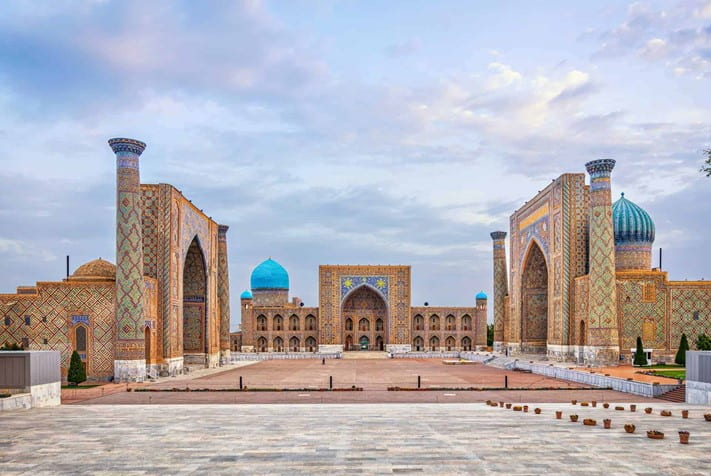 The splendid Registan square in Samarqand was built under the patronage of Timur and his descendants in the 14th and 15th centuries.
The splendid Registan square in Samarqand was built under the patronage of Timur and his descendants in the 14th and 15th centuries.
 The Shahi Zinda “Living King” Mausoleum complex includes many other examples of Timurid architecture in Samarkand
The Shahi Zinda “Living King” Mausoleum complex includes many other examples of Timurid architecture in Samarkand
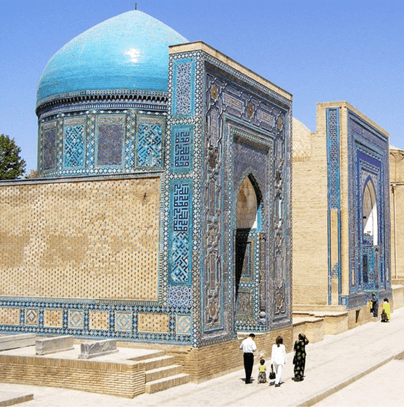 It is famous for its kufic tile designs, shown here along the border of the mausoleum.
It is famous for its kufic tile designs, shown here along the border of the mausoleum.
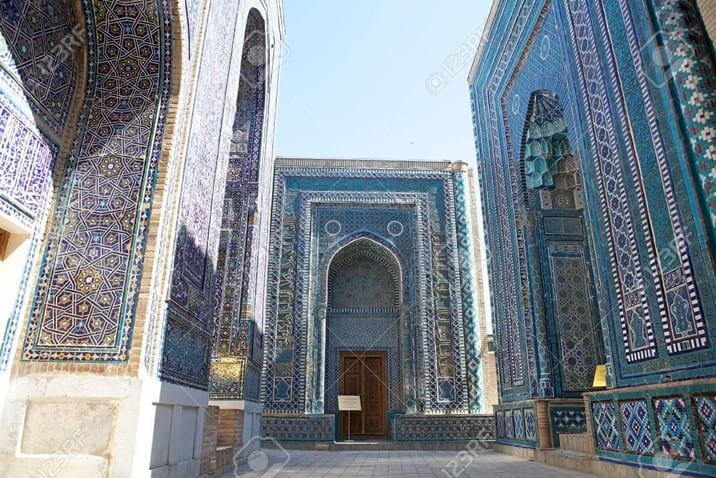 A close up of tile work at the Shahi Zinda (Photo by Maurizio Giovanni Bersanelli)
A close up of tile work at the Shahi Zinda (Photo by Maurizio Giovanni Bersanelli)
One famous legacy from the Timurid period is the observatory built by Timur’s grandson, Ulugh Beg.
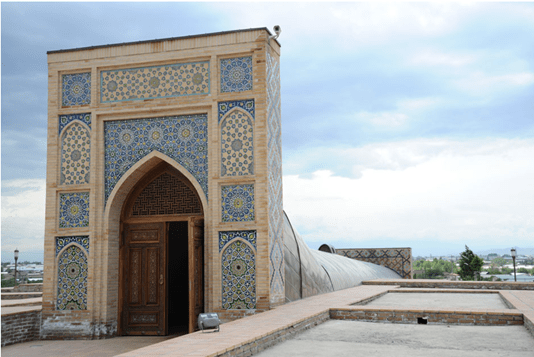 An outdoor view of the observatory
An outdoor view of the observatory
 The view from inside the observatory
The view from inside the observatory
Ulugh Beg, whose name means “the great ruler” in Turkic, patronized the building of this observatory in Samarqand in the 1420s. He is best known for his contribution to the discovery and charting of over one thousand stars. These discoveries were the largest since the second century Roman polymath Claudius Ptolemy and would not be repeated until the times of the sixteenth century Danish astronomer Tycho Brahe. His work Zij-i Sultani, written in 1437, mentions 994 stars and was eventually translated into Latin in 1665. A letter written by the mathematician and astronomer Jamshīd al-Kāshī, who was patronized by Ulugh Beg, shows that, not only were works like al-Biruni’s Canon Masudicus still read in Samarqand in the 1420s, but that Ulugh Beg himself had knowledge of Arabic, Persian, Turkic, Mongolian and Chinese and had a distinguished style of handwriting. He also composed original poetry.
The Timurids are also famous for their patronage of Uzbekistan’s “Shakespeare,” the great poet and statesman Alisher Navoiy (1441-1501).
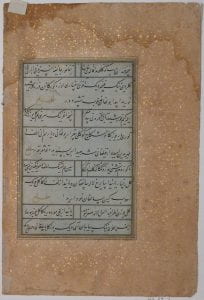 A manuscript of Navoiy’s verses on gold inflected paper found in Bukhara dated to the early 16th Century
A manuscript of Navoiy’s verses on gold inflected paper found in Bukhara dated to the early 16th Century
Here is a wisdom verse from Navoiy:
Odamiy ersang, demagil odami
Onikim, yo’q xalq g’amidin g’ami
If [you call yourself] a human (man), do not call those “human,”
[the] ones who feel no grief from [other] people’s desolation
Follow this link to read more of Navoiy’s poems: https://archive.org/stream/SelectedGazelsOfNavoiy/Gazels_djvu.txt
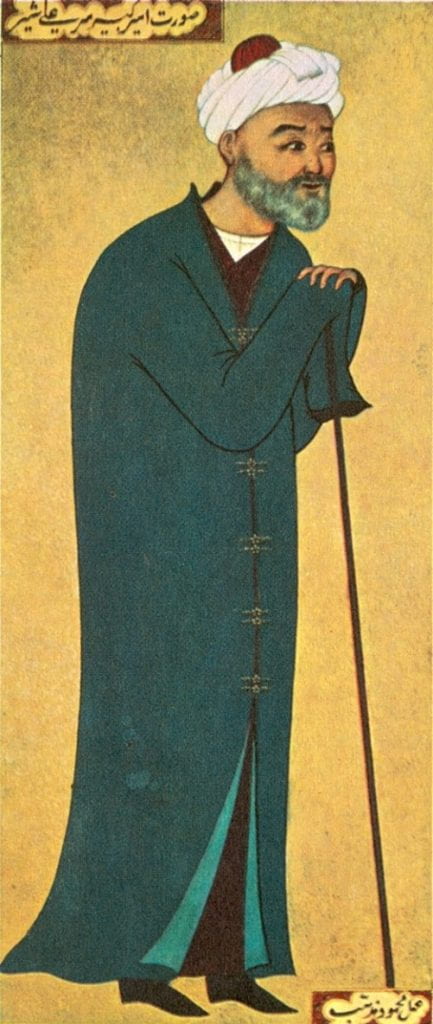 A painting of Navoiy from the Herat school of miniature painting (US public domain)
A painting of Navoiy from the Herat school of miniature painting (US public domain)
 Navoiy on a commemorative coin from 2001 issued by the Central Bank of the Republic of Uzbekistan in celebration of his 560th birthday
Navoiy on a commemorative coin from 2001 issued by the Central Bank of the Republic of Uzbekistan in celebration of his 560th birthday



